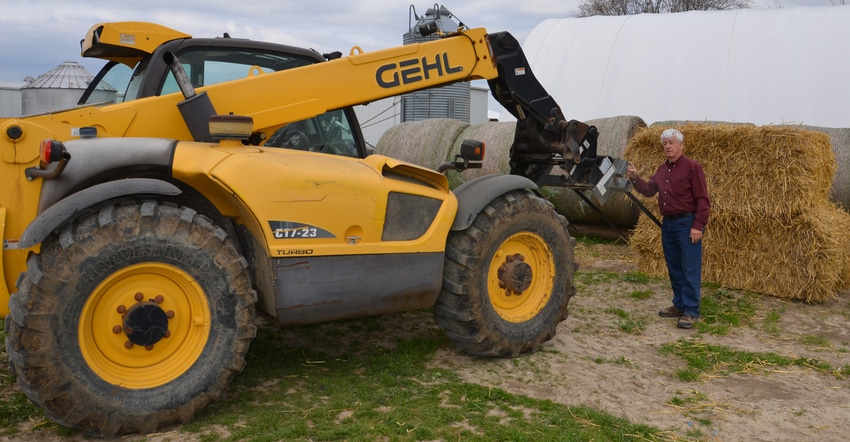
The most common place you find a telehandler in the Midwest is at a farm show. You obviously find utility tractors with loaders, skid steers and even some wheel loaders, often on bigger livestock farms. But it’s rare to find a telehandler on a farm.
Yet Stan Poe, Franklin, says it’s a key piece of equipment in his family’s operation. Poe, wife Carol, and sons Stanley II and Kalen own and co-manage Poe Livestock Farms. Their breeding flock includes 500 Hampshire ewes, and they produce primarily for the breeding market.
“Our hay operation is mechanized,” Poe says. “We bale with big square bales or big round bales. We don’t use small squares anymore because that system is too labor-intensive.”
Versatility matters
What really appeals to the Poes with a telehandler is that it’s more flexible and more versatile than other tools they could use to do some of the big moving jobs around the farm. They also have a skid-steer loader; they had it before they purchased the telehandler. However, some jobs are better-suited to the telehandler, Poe notes.
The Poes use hoop buildings on their farm. Typically, they stack hay in one of the hoops and then feed it out or sell it during the winter. They stack bales as high as they can inside the hoop building. “The telehandler is really good for stacking and retrieving bales that are higher up,” Poe notes.
Safety is important with skid steers, and it’s also important with telehandlers. Their unit is equipped with a cab. It also has a device on the bale fork unit designed to prevent a bale from falling backward onto the cab.
Future for telehandlers
Penton Ag’s Willie Vogt wrote about telehandlers in the May edition of his Farmer Iron column, which runs every month in Indiana Prairie Farmer. He interviewed Ray Bingley, general manager, ag sales, for JCB. If you go to a farm show in Europe, you will see arms of telehandlers sticking out of one booth and then another all over the show. That’s not the case in the U.S. — at least not yet. The market for this tool in the U.S. hasn’t taken off, Bingley says.
“A farmer will get a skid-steer loader, and when his needs evolve, he’ll move up to a tractor and loader,” Bingley told Vogt. The third step, if they need more capacity yet, is usually a wheel loader.
In Europe, farmers move to the telehandler in that process, often fairly quickly. Bingley believes U.S. farmers haven’t yet realized the advantages of a telehandler. He says telehandlers can work faster and reach higher, and European farmers tend to be aware of these advantages.
No one has to convince Poe of the benefits of having a telehandler with the ability to go higher and reach farther than traditional skid steers or tractor loaders. It’s certainly earned a place in their operation, he concludes.
About the Author(s)
You May Also Like




